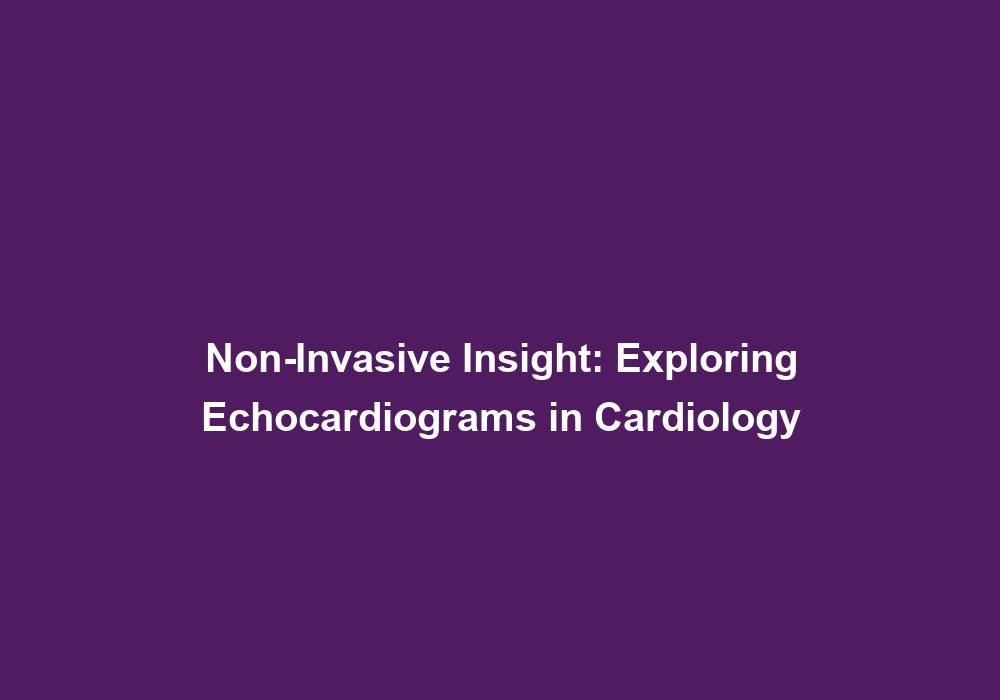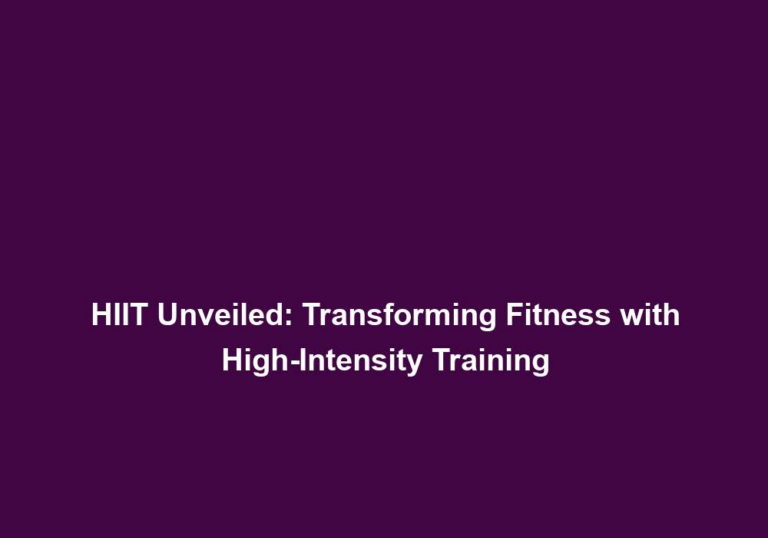Non-Invasive Insight: Exploring Echocardiograms in Cardiology
Echocardiograms play a crucial role in modern cardiology by providing valuable insights into the functioning of the heart. As a non-invasive imaging technique, echocardiography uses ultrasound waves to produce detailed images of the heart’s structures and assess its overall health. In this article, we will delve into the world of echocardiograms, exploring their significance, applications, and benefits in the field of cardiology.
What is an Echocardiogram?
An echocardiogram, also known as an echo, is a diagnostic test that utilizes high-frequency sound waves to create images of the heart. This non-invasive procedure allows healthcare professionals to visualize the heart’s chambers, valves, blood vessels, and other structures in real-time. By capturing these images, doctors can evaluate the heart’s function, identify abnormalities, and diagnose various cardiovascular conditions.
Echocardiograms are an invaluable tool in cardiology, providing accurate and detailed information about the heart’s structure and function. They are widely used to diagnose a wide range of heart diseases, including coronary artery disease, heart valve disorders, heart failure, and congenital heart defects. By visualizing the heart’s structures and assessing its function, echocardiography enables doctors to determine appropriate treatment plans and improve patient outcomes.
The Types of Echocardiograms
There are several types of echocardiograms, each serving a specific purpose in assessing different aspects of cardiac health. These include:
1. Transthoracic Echocardiogram (TTE)
The transthoracic echocardiogram is the most common type and is performed externally on the chest. During this procedure, a technician places a transducer—a small device that emits and receives ultrasound waves—on different areas of the chest to capture images of the heart. TTE provides a comprehensive evaluation of the heart’s structures and function, aiding in the diagnosis of conditions such as heart valve disorders, heart muscle diseases, and congenital heart defects.
Transthoracic echocardiograms are highly versatile and can be used to assess various aspects of cardiac health. They allow healthcare professionals to evaluate the size and shape of the heart, assess the thickness and motion of the heart muscle, and detect any abnormalities in the heart valves. Additionally, TTE can provide valuable information about blood flow patterns, allowing doctors to identify conditions such as regurgitation or stenosis.
2. Stress Echocardiogram
A stress echocardiogram is performed while the patient is exercising or undergoing pharmacological stress. By recording images of the heart at rest and during stress, this test helps identify potential areas of reduced blood flow to the heart muscle, indicating the presence of coronary artery disease.
Stress echocardiograms are particularly useful in evaluating the heart’s response to physical exertion or stress. During exercise or pharmacological stress, the heart works harder, and any areas of reduced blood flow become more apparent. By comparing the images taken at rest and during stress, doctors can determine if there are any significant changes in blood flow, which can indicate the presence of coronary artery disease or other conditions that affect blood flow to the heart.
3. Transesophageal Echocardiogram (TEE)
A transesophageal echocardiogram involves the insertion of a specialized probe into the esophagus to obtain clearer and more detailed images of the heart. TEE is particularly useful in assessing the heart’s structures that are obscured by the lungs during a transthoracic echocardiogram. It is commonly used to evaluate conditions such as blood clots, valve abnormalities, and infective endocarditis.
Transesophageal echocardiograms allow for a more detailed examination of the heart, as the esophagus is located closer to the heart than the chest wall. This proximity provides clearer images of the heart’s structures, allowing healthcare professionals to assess valve function, detect blood clots, and identify any abnormalities or infections. TEE is often used when a more detailed evaluation is needed or when a transthoracic echocardiogram does not provide sufficient information.
4. Doppler Echocardiogram
Doppler echocardiography uses the Doppler effect to measure the speed and direction of blood flow within the heart. This technique aids in assessing the functioning of the heart valves, detecting abnormal blood flow patterns, and evaluating conditions like regurgitation or stenosis.
Doppler echocardiograms provide valuable information about blood flow within the heart, allowing doctors to assess the functioning of the heart valves and detect any abnormalities. By measuring the speed and direction of blood flow, Doppler echocardiography can identify conditions such as valve regurgitation (leakage) or stenosis (narrowing). This information is crucial for diagnosing and managing various cardiovascular conditions, as abnormal blood flow patterns can indicate underlying heart problems.
The Role of Echocardiograms in Cardiology
Echocardiography is a versatile tool in cardiology, providing invaluable information for diagnosing and managing various cardiovascular conditions. Some of the significant roles of echocardiograms include:
1. Diagnosis of Heart Diseases
Echocardiograms enable doctors to diagnose a wide range of heart diseases accurately. By visualizing the heart’s structures and assessing its function, echocardiography helps identify conditions such as coronary artery disease, heart valve disorders, heart failure, and congenital heart defects. These diagnoses are crucial for determining appropriate treatment plans and improving patient outcomes.
Echocardiograms are an essential diagnostic tool in cardiology, as they provide detailed and accurate information about the heart’s structure and function. By visualizing the heart’s chambers, valves, and blood vessels, echocardiography allows doctors to identify abnormalities and diagnose various cardiovascular conditions. This information is crucial for determining the most appropriate treatment plans and improving patient outcomes.
2. Monitoring Heart Function
Echocardiograms play a vital role in monitoring the heart’s function over time. They allow healthcare professionals to assess changes in heart size, muscle thickness, and blood flow patterns, which are important indicators of heart health. By regularly monitoring these parameters, doctors can adjust treatments and interventions as necessary, ensuring optimal management of cardiovascular conditions.
Regular monitoring of cardiac function is essential for managing cardiovascular conditions effectively. Echocardiograms provide valuable information about changes in heart size, muscle thickness, and blood flow patterns, allowing doctors to assess the progression of heart diseases and adjust treatment plans accordingly. By closely monitoring these parameters, healthcare professionals can ensure that patients receive the most appropriate care and interventions to maintain optimal heart health.
3. Guiding Cardiac Procedures
Echocardiography is used to guide various cardiac procedures, including valve repair or replacement, coronary angioplasty, and pericardiocentesis. Real-time imaging provided by echocardiograms allows doctors to visualize the heart during these interventions, ensuring accurate placement of devices, precise measurements, and improved procedural outcomes.
Echocardiograms provide real-time imaging of the heart, enabling doctors to guide cardiac procedures with precision. By visualizing the heart’s structures during interventions, healthcare professionals can ensure accurate placement of devices, precise measurements, and improved procedural outcomes. This real-time guidance enhances the safety and effectiveness of cardiac procedures, leading to better patient outcomes.
4. Assessing Cardiac Function in Athletes
Echocardiography plays a crucial role in assessing cardiac function in athletes, particularly in detecting conditions such as hypertrophic cardiomyopathy—a leading cause of sudden cardiac arrest in young athletes. By evaluating heart structure, function, and blood flow patterns, echocardiograms aid in determining an athlete’s suitability for high-intensity training and identifying any potential cardiovascular risks.
Assessing cardiac function in athletes is essential to ensure their safety during high-intensity training and competition. Echocardiograms provide valuable information about the structure, function, and blood flow patterns of the heart, allowing doctors to identify any abnormalities or conditions that may pose a risk to athletes. By evaluating these parameters, healthcare professionals can make informed decisions regarding an athlete’s suitability for intense physical activity and implement preventive measures to reduce the risk of sudden cardiac events.
Benefits of Echocardiography
Echocardiography offers several advantages that contribute to its widespread use in cardiology. These benefits include:
- Non-invasiveness: Echocardiograms are non-invasive and do not require the use of harmful radiation or contrast dyes, making them safe and well-tolerated by patients.
- Real-time Imaging: Echocardiography provides real-time images, allowing healthcare professionals to observe the heart’s structures and function immediately. This immediacy aids in prompt diagnosis and facilitates timely decision-making.
- Portability: Modern echocardiography equipment is portable, making it easily accessible in different healthcare settings, including clinics, hospitals, and even remote areas. This portability ensures that patients can receive necessary cardiac evaluations promptly, regardless of their location.
- Cost-effectiveness: Compared to other imaging techniques, echocardiography is relatively cost-effective while still providing accurate and detailed information about the heart. This affordability allows for broader accessibility and more frequent use in clinical practice.
In conclusion, echocardiography has revolutionized the field of cardiology, offering non-invasive and detailed insights into the structure and function of the heart. With its various types, echocardiograms provide a comprehensive evaluation of cardiac health, aiding in diagnosis, monitoring, and guiding cardiac procedures. The numerous benefits of echocardiography, such as portability, cost-effectiveness, and real-time imaging, make it an indispensable tool in the field of cardiology, contributing to improved patient care and outcomes.







